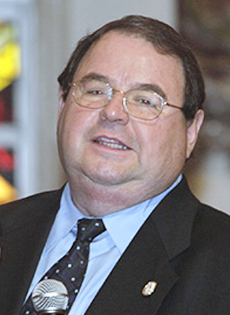
Deaconesses of the Third Century
Monday, October 31, 2016
Rogelio Zelada
In the first century, Jerusalem, the holy city, is not only the site of the great pilgrimages of Israel, but also of the great confluence of Jews who have come from many parts of the world to spend their last days by the Temple and be buried near its walls. Among the community of the children of Israel were millions who lived or were born in the large diaspora. Alexandria, Rome and Macedonia harbored many of them, followers of the Law and the Israelite religion who had assumed the Greek culture and language, common at the time. Many of them entered the first community of Jerusalem when they accepted the faith and the way of Jesus Christ.
The Temple authorities denied access to a good number of Christian widows, who could not partake of these meals that were served free of charge to the poor and orphans. The small apostolic community had to feed them with their limited resources. The Acts of the Apostles narrates an unpleasant episode that collects the complaints of those new Christians, Jews of Greek culture, or Hellenists, because their widows were discriminated against in the distribution of food.
The text allows us to see much more than a small incident. We discover the form or procedure by which all ministries arise in the Church. In response to the need to feed the Greek widows, the Holy Spirit intervenes, bestowing gifts and charisms, with the Church establishing relevant regulations, so that the service is done according to the mind and the mandate of Christ. The Spirit and the Church call, inspire, motivate. It is what we call a vocation, and every vocation always leads to a ministry. So from the beginning, every time a need exists in the Church of Christ, a corresponding ministry appears. In the same way, if the need disappears, so does the ministry.
Women held relatively influential positions in the early Church, despite the influence, at the time, of the cultural weight of the male figure. So, a quarter of the people who were working with Paul were women. Phoebe, bearer of the letter to the Romans, is recognized as "deaconess," patroness or president of the church of Cenchreae, in the port of Corinth. She exercised leadership roles with significant responsibility in her community. Apphia appears in the Letter to the Colossians, and founded a domestic church with Philemon and Archippus. Named very often are Prisca (or Priscilla), wife of Aquila, leaders of a church at Ephesus and Paul's predecessors in the missionary task; and, among many others, Junia is named with the title of “apostle,” no less.
Therefore, to address important needs of charity, faith formation and liturgical functions, the Church establishes the ministry of deaconesses, a service of versatile character that would assume various functions, according to the different needs of the people of God. Thus, in the third century, they will take charge of caring for the poor and the sick, preparing women for baptism, helping to undress and dress them, and anoint them. From the third to the fourth century, deaconesses will have a broad participation in the order of the Word, charity, worship and prayer, instruction and even management. In the fourth century they emerge as part of the clergy and receive their ministry by the laying on of hands by the bishop himself. The Apostolic Constitutions place the rite of laying on of hands by the bishop on the new deaconesses between the diaconate (sacrament of divine order) and the subdiaconate (the first of the orders established by the Church).
The bishop was the only one who had the power to consecrate them and did so surrounded by the priests, deacons and deaconesses of the Church. He imposed hands on the aspirant while uttering a beautiful prayer of consecration as a preface.
Deaconesses were instituted for the service of charity to the poor, in the distribution of food or alms. They were to provide shelter to the sick and destitute and to abandoned children. They helped care for the virgins and widows of the community, and their opinion was very often sought after by the bishop. During liturgy, they would watch the door intended for women, accommodate them and maintain order in the space reserved for them.
Their most important ministry was in the baptismal rite of adult female neophytes, whom they prepared throughout their catechumenate. They had to anoint them with holy oil and lead them by the hand to the pool for the triple baptismal immersion. Once this was concluded, they accompanied the women back to the bishop to be anointed on the forehead, ears and lips with scented chrism.
The Didascalia Apostolorum, a document of the third century written in Syriac, tells the bishops to “appoint for thyself workers of righteousness and helpers, to help with thee to life, electing those who please thee from all the people. The man who is elected is for many oversights that are required, but a woman for the service of the women; for there are houses where thou canst not send a Deacon to the women on account of the heathen. … Send a Deaconess for many things. The office of a woman Deaconess is required first, when women go down to the water, it is necessary that they be anointed by a Deaconess. Let a man repeat over them the names of the invocation of the Godhead in the water. And when she that is baptized arises from the water let the Deaconess receive her, and teach her and educate her, in order that the unbreakable seal of baptism be with purity and holiness.”
Although the Council of Chalcedon orders that women who have reached the age of 40 be chosen for deaconesses, the Didascalia Apostolorum prefers that deaconesses be designated among those who had already turned 50.
The Apostolic Constitutions instructed that they be venerated as the Paraclete of the Lord, because "just as no one can achieve faith in Christ but by the doctrine of the Holy Spirit, so no woman should approach the deacon or the bishop but by the deaconess." Deaconesses were under the authority of the bishop and in many communities had a place reserved in the Sunday assembly. Even though Clement of Alexandria lists them alongside bishops and priests, deaconesses were never ordained, but instituted.
There are more than 20 holy martyrs in the Roman martyrology who were deaconesses.
As adult baptism gave way to children’s baptism, the role and the need for deaconesses began to disappear and, with them, the ministry. In addition, the emergence of new styles of consecrated life, and the growth of monastic houses that offered a safe haven for women, modified the place and ministry of women within the Church.


Comments from readers